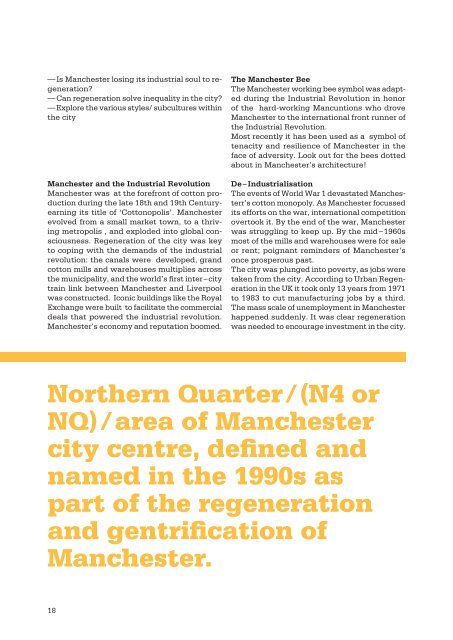THF2
You also want an ePaper? Increase the reach of your titles
YUMPU automatically turns print PDFs into web optimized ePapers that Google loves.
The Home Magazine 2018.<br />
— Is Manchester losing its industrial soul to regeneration?<br />
— Can regeneration solve inequality in the city?<br />
— Explore the various styles/ subcultures within<br />
the city<br />
Manchester and the Industrial Revolution<br />
Manchester was at the forefront of cotton production<br />
during the late 18th and 19th Centuryearning<br />
its title of ‘Cottonopolis’. Manchester<br />
evolved from a small market town, to a thriving<br />
metropolis , and exploded into global consciousness.<br />
Regeneration of the city was key<br />
to coping with the demands of the industrial<br />
revolution: the canals were developed, grand<br />
cotton mills and warehouses multiplies across<br />
the municipality, and the world’s first inter – city<br />
train link between Manchester and Liverpool<br />
was constructed. Iconic buildings like the Royal<br />
Exchange were built to facilitate the commercial<br />
deals that powered the industrial revolution.<br />
Manchester’s economy and reputation boomed.<br />
The Manchester Bee<br />
The Manchester working bee symbol was adapted<br />
during the Industrial Revolution in honor<br />
of the hard-working Mancuntions who drove<br />
Manchester to the international front runner of<br />
the Industrial Revolution.<br />
Most recently it has been used as a symbol of<br />
tenacity and resilience of Manchester in the<br />
face of adversity. Look out for the bees dotted<br />
about in Manchester’s architecture!<br />
De – Industrialisation<br />
The events of World War 1 devastated Manchesterr’s<br />
cotton monopoly. As Manchester focussed<br />
its efforts on the war, international competition<br />
overtook it. By the end of the war, Manchester<br />
was struggling to keep up. By the mid – 1960s<br />
most of the mills and warehouses were for sale<br />
or rent; poignant reminders of Manchester’s<br />
once prosperous past.<br />
The city was plunged into poverty, as jobs were<br />
taken from the city. According to Urban Regeneration<br />
in the UK it took only 13 years from 1971<br />
to 1983 to cut manufacturing jobs by a third.<br />
The mass scale of unemployment in Manchester<br />
happened suddenly. It was clear regeneration<br />
was needed to encourage investment in the city.<br />
Northern Quarter / (N4 or<br />
NQ) / area of Manchester<br />
city centre, defined and<br />
named in the 1990s as<br />
part of the regeneration<br />
and gentrification of<br />
Manchester.<br />
The Manchester Ship Canal<br />
An untouched piece of Manchester’s industrial<br />
past are the canals that run through the city.<br />
The Manchester Ship Canal was built in 1894 to<br />
cope with the demands of the industrial revolution.<br />
The canals were key to commercial imports<br />
and exports and were fundamental in defining<br />
Manchester as the Cotton Capital of the world.<br />
As the cotton industry declines so did the commercial<br />
usage of the canals as they struggled<br />
to facilitate modern ships. The canals have remained<br />
dormant ever since, however, Peel Ports<br />
Ltd. Have recently started an effort to regenerate<br />
the canal to the frustration of some critics.<br />
‘There’s no place like Hulme’<br />
In the wake of deindustrialised Manchester,<br />
housing slums, housing the working class of<br />
Manchester, were a common sight. Yet in areas<br />
of poverty, a strong sense of community thrived<br />
The Hulme Crescents<br />
The slums in Hulme were particularly notorious<br />
and the in the early 1970’s the slums were demolished<br />
and a high density housing scheme<br />
called the ‘Hulme Crescents’ rehomes residents.<br />
The scheme was a failure from start to finish,<br />
and became a symbolic of inner city deprivation<br />
in Manchester. They fractured an existing<br />
community and are an example of regeneration<br />
gone awry. They were demolished in 1194, 22<br />
years after they were constructed.<br />
WATCH VIDEO<br />
Following the demolition Manchester City Council<br />
received government funding to regenerate<br />
Hulme. Cooperation between local authority<br />
and private and public groups meant it would<br />
be rebuilt with the values of the community in<br />
mind and to the extent that it could re – establish<br />
itself.<br />
‘Homes for Change’ a community led housing<br />
cooperative which was unique not only in its<br />
architecture but also the process in which it<br />
was made. The medium-rise blocks reflect the<br />
diverse community and were practical truly suiting<br />
the residents. The project was a success<br />
and showed that regeneration could work for<br />
all parties involved where residents were consulted<br />
in the process.<br />
THE GENTRIFICATION OF MANCHESTER’S<br />
POP CULTURE<br />
Manchester: Pop Cult City<br />
The Smiths to Oasis , Coronation Street to Manchester<br />
United, Factory Records to Canal Streetto<br />
name a few cultural artefacts that have gone<br />
on to shape not only the symbolic transformation<br />
of Manchester, but also the physcial structure<br />
of the city. The economic impact it has had on<br />
the city is immeasurable.<br />
LISTEN SOUNDBITE<br />
The Hacienda<br />
The Hacienda was an infamous superclub<br />
that pioneered the Madchester house scene.<br />
Its movement stiumlated the night-time culture<br />
as many more night clubs followed in its<br />
course rejuvenating previosuly bleak areas of<br />
Manchester.<br />
WATCH VIDEO<br />
The Hacienda closed due to financial issues in<br />
1997 and luxury flats were built on its site. Gentrification<br />
is prevalent across Manchester with<br />
other legendary venues following suite such as<br />
The twisted Wheel, the home of norther soul being<br />
developed as a budget hotel and even more<br />
recently Sankey’s also being turned into flats.<br />
The venues and movements that defined Manchester<br />
as a pop cult city, which started out as<br />
a counter culture movement, have been appropriated<br />
as a cultural asset. Some argue that it<br />
has taken the edge out of the city, and instead<br />
replaced it with luxury flats and chain coffee<br />
shops.<br />
https://capitadiscovery.co.uk/mmu/<br />
items/1615466?query=Dave+Haslam&resultsUri=items%3Fquery%3DDave%2BHaslam<br />
TO THE NORTHERN QUARTER…<br />
REGENERATION IN THE 1990S<br />
The city centre<br />
The fervour of regeneration took over the city<br />
following the failed Summer Olympic bid and<br />
1996 IRA bomb that ravaged the city. The Manchester<br />
Arndale, Royal Exchange and Corn<br />
Exchange buildings were partially rebuilt, and<br />
sites such as the Manchester Arena and The<br />
Velodrome were built.<br />
Spinningifields, Manchester’s business district<br />
did not formally exist until London Properties<br />
Ltd. Invested into the area driving employment<br />
18<br />
19



